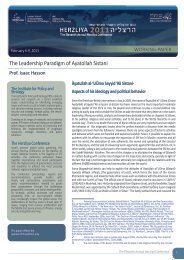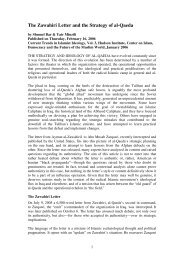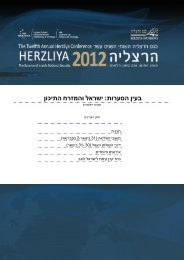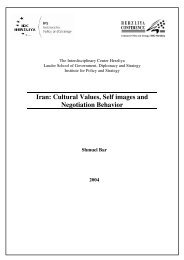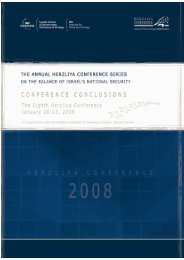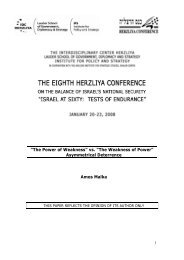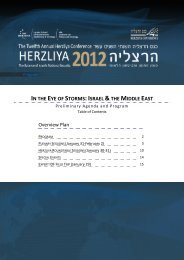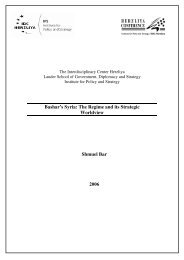Classical Islamic Paradigms of Deterrence and their Expression in ...
Classical Islamic Paradigms of Deterrence and their Expression in ...
Classical Islamic Paradigms of Deterrence and their Expression in ...
You also want an ePaper? Increase the reach of your titles
YUMPU automatically turns print PDFs into web optimized ePapers that Google loves.
cultural epochs, from Roman Antiquity to German Classicism. If one enters <strong>in</strong>to a conflict with an adversarysuch as the Greeks, one might be defeated by stratagem. Vergil uses the concrete term for fear, "timeo"<strong>and</strong> implies the Trojan Horse as object <strong>of</strong> fright, yet he expresses actually a general feel<strong>in</strong>g <strong>of</strong> fear from theGreeks. Such a dona-phobia (fear <strong>of</strong> presents) could aga<strong>in</strong> be expla<strong>in</strong>ed with different perceptions <strong>of</strong> fear <strong>in</strong>antiquity. Despite <strong>their</strong> cultural <strong>and</strong> geographic closeness, antique Mediterranean cultures had verydifferent relationships to <strong>their</strong> emotions. Stoics <strong>and</strong> Epicureans, for example, despised fear as an artificiallycreated feel<strong>in</strong>g. The remedy was composure (atoraxia), which is comparable to the 19 th century Prussianvalue system that was <strong>in</strong>fluenced by neo-classicist ideas. Toughness aga<strong>in</strong>st oneself <strong>and</strong> one’s fears wascompensated by sense <strong>of</strong> duty (Pflichtbewusstse<strong>in</strong>). However, other trends <strong>of</strong> antique culture treatedirrational states <strong>of</strong> fear with great awareness. In Greek mythology, Phobos means similar to the Lat<strong>in</strong> timor"fright" <strong>and</strong> is fixed to a concrete threat, yet it emanates from an <strong>in</strong>ner state <strong>of</strong> fear. 46 The mythology,which Muslims foster <strong>in</strong> times <strong>of</strong> conflict, has its own classical <strong>and</strong> modern idols <strong>of</strong> terror. For example, theself-sacrificial attacker (munghamis) at the siege <strong>of</strong> Constant<strong>in</strong>ople <strong>in</strong> 674 is an important figure <strong>in</strong> jihadifright <strong>and</strong> deterrence perceptions; as well as B<strong>in</strong> Laden, or Abd al-Aziz al-Muqr<strong>in</strong>, the former leader <strong>of</strong> al-Qaeda <strong>in</strong> Saudi Arabia (killed 2003); but also CIA-attacker Abu Dujana al-Khorasani (2009). They areperceived as almost sa<strong>in</strong>t-like figures who threw dreadful wrath upon <strong>their</strong> enemy, the enemies <strong>of</strong> allMuslims, were guided by God, now reside <strong>in</strong> paradise <strong>and</strong> are full <strong>of</strong> love for <strong>their</strong> own k<strong>in</strong>.The veneration <strong>of</strong> some Sunni idols <strong>of</strong> fear by followers strongly borrows from Sufi, even rem<strong>in</strong>ds <strong>of</strong> Shiitemartyrdom spirituality. But it is reversed <strong>in</strong>to a martial <strong>and</strong> terrorist cult, which culm<strong>in</strong>ates <strong>in</strong> expressions <strong>of</strong>total devotion to <strong>in</strong>spirational figures (fan-pictures, posters, wall-banners, movies, discourses, etc.). Sometrends <strong>of</strong> <strong>Islamic</strong> fundamentalism (similar to Christian <strong>and</strong> Jewish counterparts) very consciously cultivatestates <strong>of</strong> fear. Div<strong>in</strong>e comm<strong>and</strong> <strong>and</strong> human piety are strongly based on different threat scenarios that causefear <strong>and</strong> explicate prohibitions aga<strong>in</strong>st <strong>in</strong>fr<strong>in</strong>gements.But cultural perceptions change over time. While a statue was a worshipped cult-object for antique Greeks,medieval Christian clerics saw it as a frighten<strong>in</strong>g idol (Abgott). Yet, both perceived its s<strong>in</strong>gularity, <strong>in</strong> otherwords, its aura. 47 S<strong>in</strong>ce the 1980s scholars have started <strong>in</strong>tegrat<strong>in</strong>g new concepts <strong>in</strong>to deterrence <strong>in</strong>clud<strong>in</strong>gthe "<strong>in</strong>terpretative version <strong>of</strong> the concept <strong>of</strong> strategic culture." 48 The mystic "aura" <strong>of</strong> suicide attackers <strong>and</strong>sla<strong>in</strong> jihadi leaders is highly flexible on the level <strong>of</strong> <strong>in</strong>terpretative culture <strong>and</strong> depends on socio-politicalcontext. The acceptance <strong>of</strong> suicide-deterrence has been "learned" through a bitter history <strong>of</strong> asymmetricconflicts, <strong>and</strong> has become ever stronger over the last 15 years. 30 years ago, Muslim publics wouldprobably have reacted extremely "deterred" by the idea that sectarian co-religionists commit dozens <strong>of</strong>suicide bomb<strong>in</strong>gs each year.States <strong>of</strong> consciousness dread <strong>and</strong> scare, accord<strong>in</strong>g to the French <strong>in</strong>tellectual Georges Bataille (1897-1962),are the impetus for prohibitions. A prohibition or negative rule only works, if a scare or dread scenario hasbeen established, which is effectively caus<strong>in</strong>g the ab<strong>and</strong>onment <strong>of</strong> actions out <strong>of</strong> fear from the results. TheGreeks <strong>in</strong> the Aeneis see Friedrich Schiller, Schiller’s sämmtliche Werke (Paris: Felix Loqu<strong>in</strong>,1837), 29. "Die Griechen fürchte ich, unddoppelt, wenn sie schenken."46 Phobos <strong>and</strong> Deimos were the gods <strong>of</strong> dread <strong>and</strong> terror <strong>in</strong> Greek mythology <strong>and</strong> <strong>their</strong> counterpart <strong>in</strong> Roman mythology was Metus. InGreek mythology, Phobos means similar to the Lat<strong>in</strong> timor "fright." Phobos is fixed to a concrete threat, yet it emanates from an <strong>in</strong>ner state<strong>of</strong> fear. Phobos <strong>and</strong> Deimos are the tw<strong>in</strong> sons <strong>of</strong> the God <strong>of</strong> War, Ares, <strong>and</strong> the Goddess <strong>of</strong> Love, Aphrodite.47 Walter Benjam<strong>in</strong>, "Das Kunstwerk im Zeitalter Se<strong>in</strong>er Technischen Reproduzierbarkeit", Berl<strong>in</strong>, Suhrkamp, 2010, p. 21. The <strong>in</strong>fluence <strong>of</strong>Greek culture <strong>in</strong> the Roman Empire greatly contributed to the acceptance <strong>of</strong> Christianity, which resulted <strong>in</strong> the establishment <strong>of</strong> the"Heiliges Römisches Reich Deutscher Nation" (Sacrum Romanum Imperium). All <strong>of</strong> these epochs are nowadays understood as centralelements <strong>of</strong> "Abendländischer Kultur." Yet, each cultural epoch <strong>in</strong> one way or other exploited <strong>and</strong> at the same time annihilated theprevious.48 Amir Lupovici, "The Emerg<strong>in</strong>g Fourth Wave <strong>of</strong> <strong>Deterrence</strong> Theory—Toward a New Research Agenda," International Studies Quarterly 54,2010, p. 711.15



